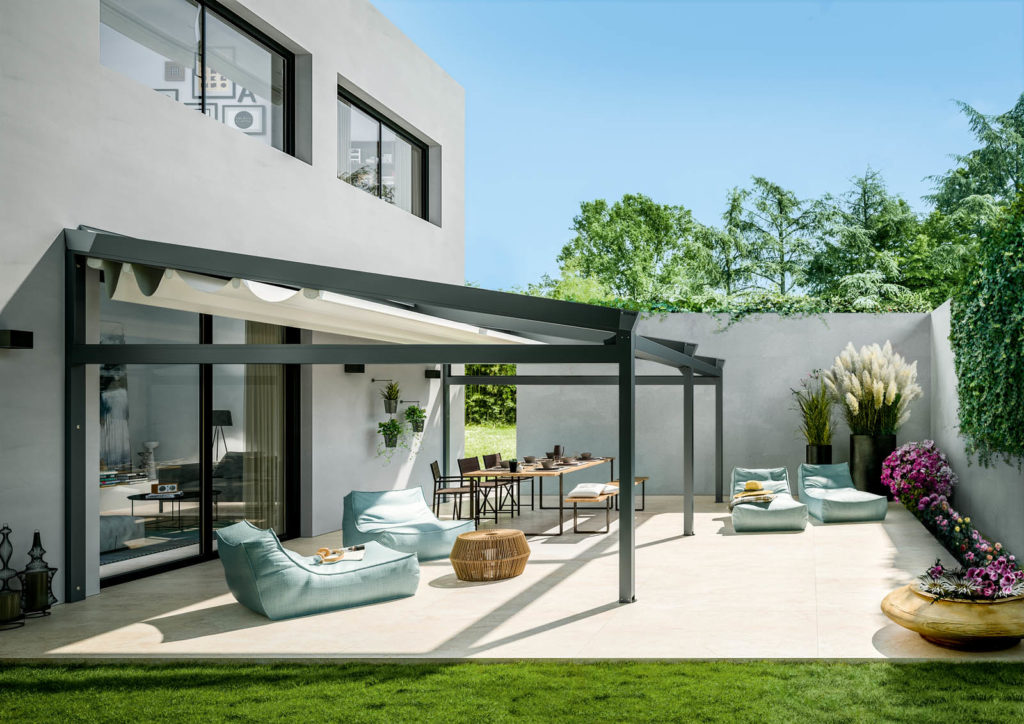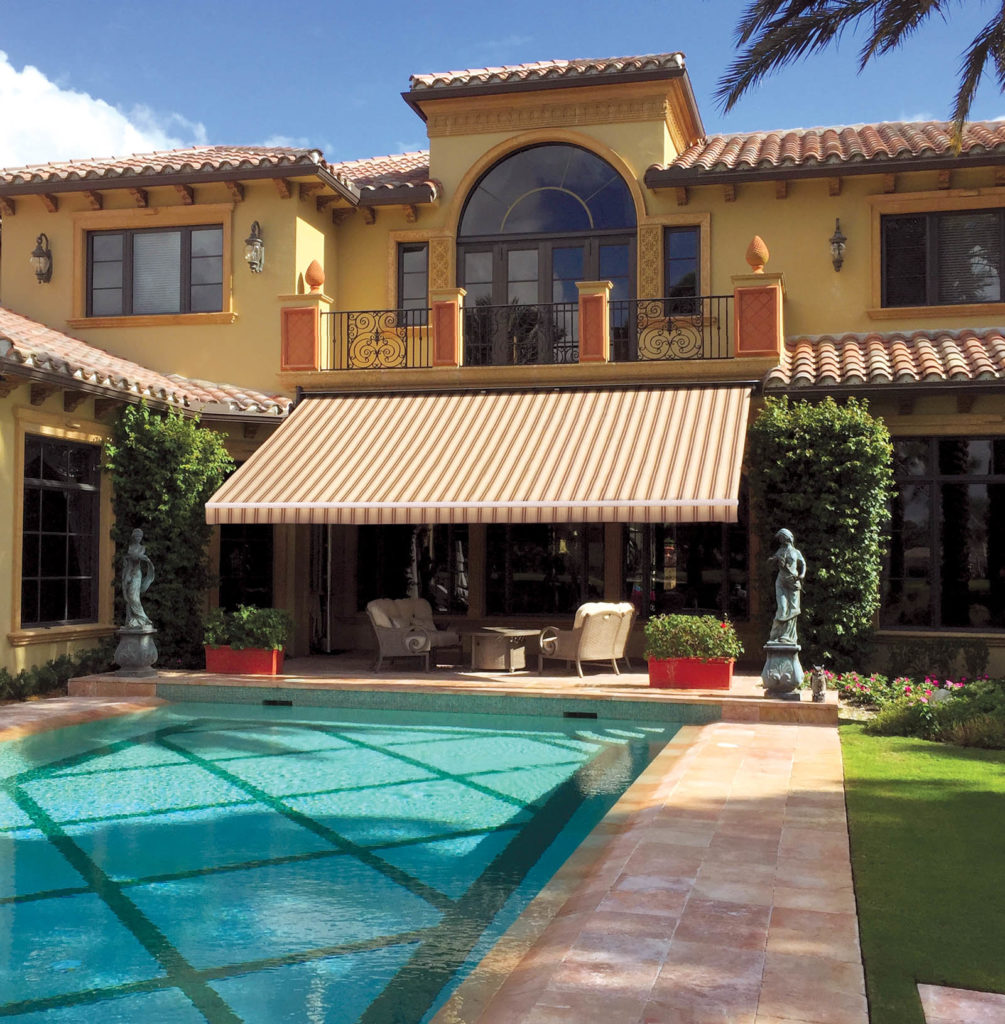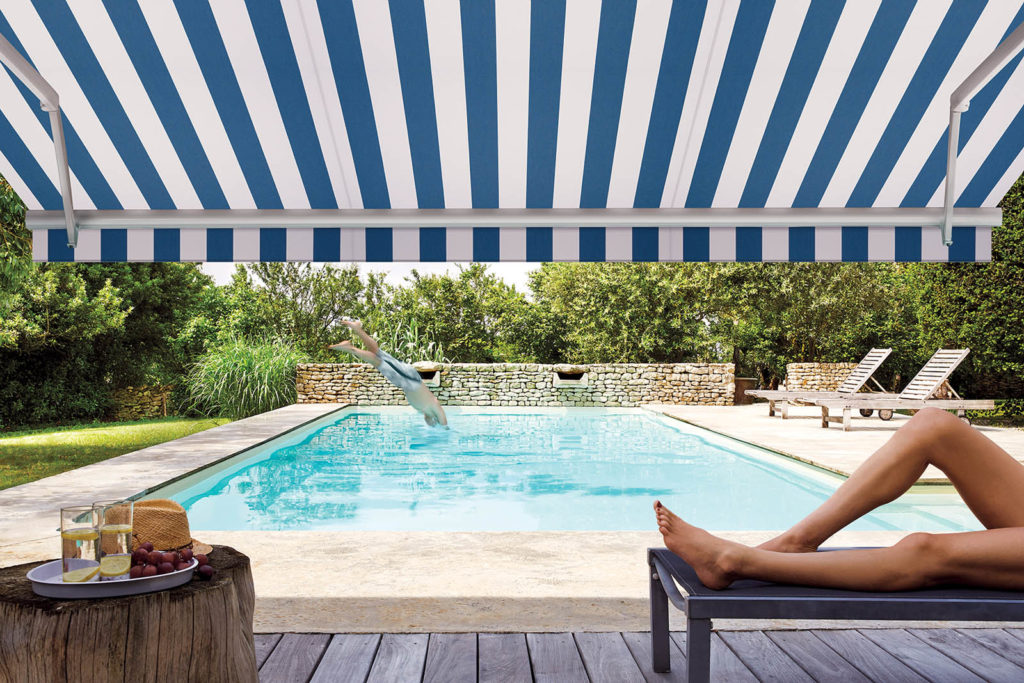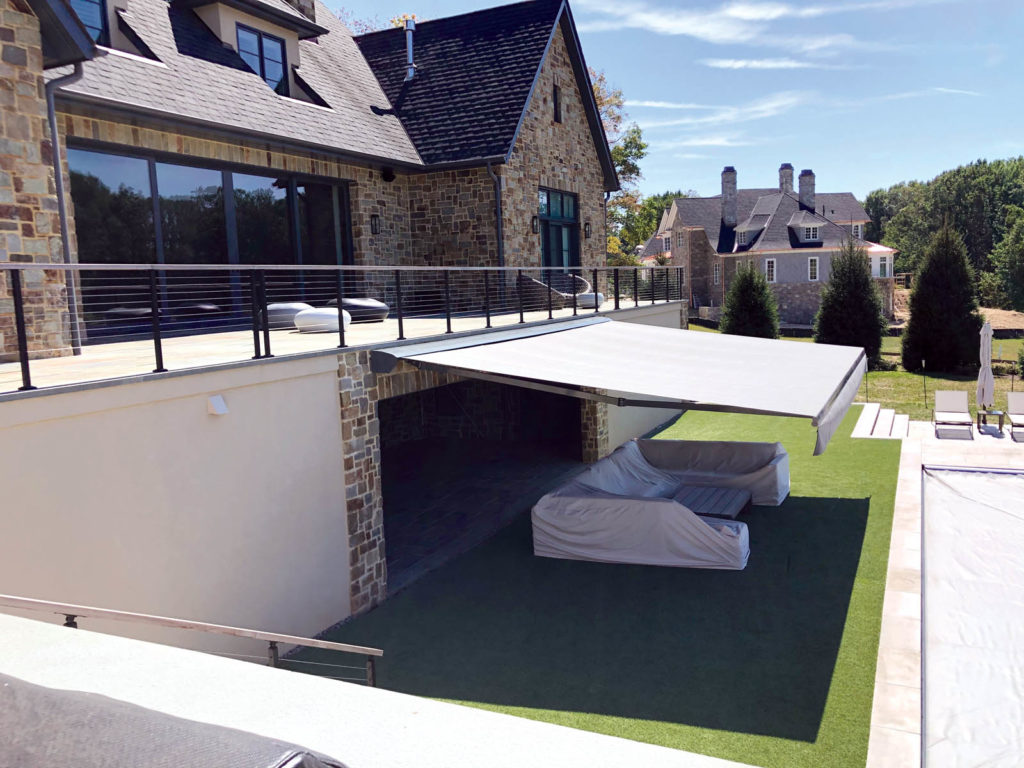There has been growth in the U.S. market for retractable awnings, but today they’re part of a wide range of shade products designed to offer comfort, color, convenience, style and protection from insects as well as weather.
by Laurie Junker
The awning industry had been anticipating a boom in retractables for a long time. Scouring back issues of this magazine over the past 20 years turns up numerous articles that predict a surge in sales to both residential and commercial customers, along with technological innovations in materials, motors and mechanisms that should add to their purchase appeal. But did it ever happen? The short answer is … not exactly. The longer answer is that there’s still a lot of potential for savvy manufacturers and dealers—and that maybe the key is appealing to the heart as well as the head.

Awnings have been widely accepted in Europe, where energy costs are high and small homes are the norm, but they’ve been slower to catch on here in the United States despite clear benefits, especially their ability to lower air-conditioning energy costs (20–25 percent or more, according to a 2007 study conducted by the Professional Awning Manufacturers Association [PAMA] and the University of Minnesota). Awnings can also protect exterior siding and interiors from damage by direct sunlight, and make outdoor spaces, such as patios and decks, cooler and more comfortable to use.
In recent years, more options in fabrics and colors have made them an aesthetic choice as well. The retractable technology gives awnings valuable flexibility—blocking hot sun when needed and allowing light in on cooler days, and protecting the awning from damage during high winds and storms. For commercial customers, awnings carry the additional benefits of branding with color and graphics and extending service options for patios and outdoor dining areas. In short, lots of benefits but still relatively low acceptance in the United States.
Promoting value
Larry Bedosky, director of marketing at Eclipse Shading Systems®, says growth hasn’t been as robust as predicted, and the problem is that most consumers just don’t see the value. “Retractable lateral arm awnings, particularly custom-made, professionally installed ones, haven’t been embraced widely in the United States,” he says. The Middletown, N.Y., manufacturer of residential and commercial awnings, screens, shades and retractable roofs has seen minimal growth in retractables over the past 10 years. According to Bedosky, that may be why many companies have expanded into other shade-related products such as louvered roofs, pergolas, interior shades and exterior screens. (For more information on screens, shades and shutters, see “Shady dealings” in the January 2020 issue of the Review.) “Yes, consumers still have the same problems with the sun, but due to changes in residential construction, these other products can solve the problem. We also see growth on the commercial side with green building techniques and LEED certifications for additional shading products.”

Sunesta® Awnings and Outdoor Comfort general manager Jeff Bedard has a slightly different take on the subject. For the Jacksonville, Fla., manufacturer of residential custom awnings and screens, the retractables market has been good. “We’re three times our size compared to 10 years ago and very optimistic,” he says. “The key has been our dealer network combined with our quality product line, marketing support and fast delivery.” The company has made developing its dealer network a priority. “Our dealers know how to present the value proposition and explain the benefits,” he says, noting that the vagaries of diverse weather in certain regions (sun, rain, snow) make “push button” retractables an easy option for some homeowners.
Global component manufacturer BAT USA sales manager Aldo Campa says that while retractable sales have been stable for the past four years, he doesn’t see a lot of growth potential because of the high number of players in the American market. “Any growth is likely to be driven by taking someone else’s clientele,” he says, adding that Europe has 10 times the sales of retractable awnings as does the United States. “In Europe, retractable awnings were just a must-have part of any new apartment building or house, but American homeowners were used to buying fixed aluminum awnings as an afterthought, and that’s waning now.”
Eric M. Scop, vice president, sales and digital marketing for Retractableawnings.com®, has also seen modest growth in the market. “Retractable folding lateral arm awnings have had a small amount of growth,” he says. “They’re purchased by homeowners and businesses including but not limited to restaurants and hotels, although most restaurants and hotels are moving toward the installation of a retractable pergola or retractable louver roof/rotating louver roof system. They can be fully enclosed and can handle heavy rain and high winds, as opposed to lateral arm awnings that are designed for light rain and light winds. They also offer much better drainage options.”
Outdoor living in style
Improvements in retractables (in both awnings and other shade structures) have been key to maintaining and growing sales, according to Scop. This includes more fabric options and colors, better durability and improved control and operating mechanisms, such as wind, motion, rain and sun sensors that trigger awnings to open or close automatically depending on the weather, as well as programmable operating systems that are in sync with the trend toward “smart homes.”
“Technology such as Somfy’s myLink™ has made it much easier for customers to control a motorized product. They can open and close and set timers from anywhere in the world using either an iOS or Android smartphone or tablet. Other technologies allow products to close before high wind and/or rain damage the frame and fabric,” Scop says.

The recent trend toward outdoor living and interior spaces that flow seamlessly between inside and out seems a positive development for retractable awnings. Erin Collis, marketing and communications manager at Corradi USA Inc., agrees with that prognosis: “Growing interest in biophilic design and outdoor living is all about the desire to spend more time in a healthier environment with family and friends and less time isolated indoors glued to a television or computer screen. Retractables can help by extending time and reasons to be outside.”
Collis acknowledges, however, that retractable awnings have not grown the way the industry had hoped. “It’s a steady growth and the potential is there, but we’ve not fully broken into that market yet.” Corradi USA, Carrollton, Texas, is the North American branch of Corradi—an Italian manufacturer of outdoor living products including Pergotenda®, louvered roof systems, retractable awnings, shade sails and drop screens for commercial and residential customers. Collis says that connecting with people on a more emotional level might be key, by showing consumers how awnings can increase and enhance the outdoor experience, and suggests that replacing the term “awnings” with the more benefit-specific “shading systems” might better communicate key attributes.
Maud Demurge, strategic marketing manager for Somfy North America, a global manufacturer of motors and controls for shading products, points out that newer shade products deliver more than just solar protection. “They also provide bug protection, the ability to maintain a cooler atmosphere, lighting and temperature management. All of these benefits enhance the experience of outdoor living and can be easily managed at the touch of a button, or even with app or voice control,” she says. Somfy reports a slight increase in retractable awning sales and “significantly higher” growth in external zip screens and pergolas over the past few years.

Light green only?
Given that retractables offer a clear benefit in reduced energy consumption and, therefore, energy costs, one would expect that consumers and businesses would consider them for that reason alone—but that doesn’t appear to be the case. Scop puts it bluntly, when asked if energy efficiency is a factor in retractable sales: “Never with residential customers and rarely with commercial clients, architects and landscape architects; and it really should be. I believe more education is needed.”
Bryan Loane, president of Baltimore, Md., awning manufacturer and dealer Loane Bros. Inc., thinks the health risk from the sun makes a more compelling case for American consumers. “Europeans tend to be ‘greener,’ so they appreciate the energy savings, but here one of the main factors is the concern for sun exposure and the risk for skin cancer,” he explains. He sees more potential from health reasons for retractables and other shade products. “I’ve seen growth, especially in public spaces like playgrounds, and anticipate it continuing.”

So what’s next?
While there’s wide agreement that a need for sun protection and the public’s growing desire to spend more time outdoors bodes well for the shade industry overall, it’s not clear how large a role retractable awnings will play. It’s likely they will continue to be part of a cast of products designed to deliver shade, comfort, weather protection and energy savings—but perhaps not as the star performer. Scop agrees that other products may gain prominence: “Retractable folding lateral arm awnings have had limited growth, whereas retractable pergolas and retractable louvered roof/rotating louver roof systems have higher rates and generate more revenue due to the average sale amount.”
According to Campa, traditional awning manufacturers will need to seek growth through new products, and he sees them as a bright light. “Screeny systems, for example, have grown more than 500 percent in the last two years,” he says. Technology will continue to evolve and make all kinds of shade products more user-friendly and compatible with home automation solutions.
Bedard adds that industry organizations such as PAMA can help lead the charge. “PAMA is a good organization, but we need more members willing to promote a complete range of residential shade products in order to generate greater awareness, even if we need to extend outside traditional awning companies, such as professional home improvement organizations. That’s been a big part of our success at Sunesta,” says Bedard.
So was there a boom in retractable awnings? In the commercial markets such as restaurants and hotels, a modest one, perhaps. But for shade products in general, offering energy savings, comfort and health benefits, technology and style for residential and commercial use, that boom is underway.
Laurie Junker is a freelance writer based in Minneapolis, Minn.
SIDEBAR: Off the Shelf?
Inexpensive DIY awning systems sold in big-box retailers and on Amazon share part of the blame for low growth on the custom side, according to Larry Bedosky, director of marketing with Eclipse Shading Systems®. On that note though, he sees a possible silver lining. “Those people buying low-end retractable awnings might realize they love the concept but don’t like that the fabric turns to confetti in a few years and a small wind can snap the arm. For their next awning, they might seek a better-quality product. This is what happened with many other outdoor-related products such as gas grills and casual furniture.”
SIDEBAR: By Design
A trend in both residential and commercial design toward modern, minimalist architecture has affected sales of certain kinds of awnings, according to some manufacturers. “The end user is becoming more cognizant of style and the modern look is what they want,” says Erin Collis, marketing and communications manager at Corradi USA Inc.
For the same reason, Mike O’Connor, sales manager for Loane Bros. Inc., is seeing increased interest in the company’s shade line. “Exterior motorized shades with tracks are very appealing to customers because of the clean look and versatility,” he says, but adds, “not every customer has that type of budget, though.”
Modern architecture is also bringing changes to the industry in terms of permanent structures, often designed by architects—such as clean-lined pergolas—according to Aldo Campa, BAT USA sales manager. “Pergolas are becoming more popular among architectural firms, more than retractables. They become part of the overall project and are often combined with lateral roll-down screens for functional outdoor living.”
 TEXTILES.ORG
TEXTILES.ORG


